Elevated Strain Rate Characterization of Compression Molded Direct/In-Line Compounded Carbon Fibre/Polyamide 66 Long Fibre Thermoplastic
Abstract
:1. Introduction
2. Materials and Methods
3. Results and Discussion
3.1. Quasi-Static Uniaxial Tensile Tests
3.2. Intermediate Strain Rate Uniaxial Tensile Tests
3.3. Quasi-Static Puncture Tests
3.4. Low-Velocity ISO 6603-2 Puncture Tests
3.5. ISO 6603 Puncture Test—Comparison of Quasi-Static and Low-Velocity Responses
3.6. Quasi-Static and Low-Velocity Impact Loading of an LFT-D Automotive Seatback
4. Conclusions
- Quasi-static uniaxial tension tests with 4 specimen gauge lengths ranging from 6.25 mm to 57 mm did not exhibit evidence of a significant size effect for elastic modulus or tensile strength. Failure strain was moderately sensitive to specimen gauge length. For the 0-degree direction, the failure strain decreased by 27.5% across the full range of gauge length studied (coefficient of variation for 0-degree specimens: 19.2%). For the 90-degree direction, the failure strain decreased by 29.9% across the full range of gauge length studied (coefficient of variation for 90-degree specimens: 22.6%).
- Intermediate strain rate tensile tests showed little to no strain rate sensitivity for both the 0-degree and 90-degree directions. This is expected since carbon fibre has little to no rate sensitivity and PA66 is not highly strain rate sensitive.
- Compared to quasi-static tensile tests, the 0-degree intermediate strain rate tests possess a more linear response compared to the decreasing stiffness (with increasing strain) of the quasi-static tests. This may be indicative of a slightly positive strain rate sensitivity of the PA66 matrix since the strain rate is ramping up throughout the test, particularly for 0-degree tests where an impact attenuator was utilized to reduce the vibration of the system.
- The 90-degree intermediate strain rate tests were characterized by a nonlinear response. This was likely caused by positive strain rate sensitivity of the PA66 matrix, to which the 90-degree tests are more sensitive. However, another factor to consider is that the 90-degree tests did not employ a vinyl rubber impact attenuator (which was present for the 0-degree tests), and thus the strain rate ramped up more rapidly and more vibration was present in the system for the novel apparatus used within this investigation.
- Low-velocity ISO 6603-2 instrumented puncture tests were completed. A quasi-static variation of this material characterization methodology was also conducted on a load frame. The initial stiffness was approximately 50% higher for low-velocity impact tests compared to the quasi-static tests and the displacement at the onset of fracture was much lower, approximately 95% lower, for low-velocity impact tests. Correspondingly, the displacement at the peak force and the peak force were reduced for low-velocity impact tests, 20% and 21%, respectively.
- The ISO 6603-2 low-velocity impact test methodology should be employed with caution for brittle materials since the kinetic energy of the specimen (and fragments thereof) as the specimen fails may be significant relative to the internal energy. Significant dynamic effects were present in the considered testing, additionally, this dynamic effect was highly sensitive to material properties and specimen geometry.
- A seatback comprised of a consistent material to the current study loaded in a similar condition had a 550% increase in initial stiffness under low-velocity impact conditions compared to quasi-static tests. DIC analysis revealed the deformation to be more localized to the indenter for low-velocity impact tests at small displacements. This dynamic effect was observed to be significant well before failure of the specimen.
Author Contributions
Funding
Institutional Review Board Statement
Informed Consent Statement
Data Availability Statement
Conflicts of Interest
References
- Ning, H.; Lu, N.; Hassen, A.A.; Chawla, K.; Selim, M.; Pillay, S. A review of long fibre thermoplastic (LFT) composites. Int. Mater. Rev. 2020, 65, 164–188. [Google Scholar] [CrossRef]
- Alshammari, B.A.; Alsuhybani, M.S.; Almushaikeh, A.M.; Alotaibi, B.M.; Alenad, A.M.; Alqahtani, N.B.; Alharbi, A.G. Comprehensive review of the properties and modifications of carbon fibre-reinforced thermoplastic composites. Polymers 2021, 13, 2474. [Google Scholar] [CrossRef] [PubMed]
- Milberg, E. GMC Reveals Carbon Fiber Truck Bed in New 2019 Sierra Denali. Available online: http://compositesmanufacturingmagazine.com/2018/03/gm-carbon-fiber-truck-bed-2019-sierra-denali/ (accessed on 21 November 2018).
- Caliendo, H. Clemson Developing Composite Vehicle Front-Door. Available online: https://www.compositesworld.com/news/clemson-developing-composite-vehicle-front-door- (accessed on 22 November 2018).
- Chouinard, T. SPE Automotive Plastics News. Available online: http://speautomotive.com/wp-content/uploads/2017/12/SPEADNews_DecFULL_LR_12_1.pdf (accessed on 22 November 2018).
- Karsli, N.G.; Aytac, A. Tensile and thermomechanical properties of short carbon fibre reinforced polyamide 6 composites. Compos. Part B Eng. 2013, 51, 270–275. [Google Scholar] [CrossRef]
- Hassan, A.; Hornsby, P.R.; Folkes, M.J. Structure-property relationship of injection-molded carbon fibre-reinforced polyamide 6, 6 composites: The effect of compounding routes. Polym. Test. 2003, 22, 185–189. [Google Scholar] [CrossRef]
- Wu, S.H.; Wang, F.Y.; Ma, C.C.M.; Chang, W.C.; Kuo, C.T.; Kuan, H.C.; Chen, W.J. Mechanical, thermal and morphological properties of glass fibre and carbon fibre reinforced polyamide-6 and polyamide-6/clay nanocomposites. Mater. Lett. 2001, 49, 327–333. [Google Scholar] [CrossRef]
- Do, V.T.; Nguyen-Tran, H.D.; Chun, D.M. Effect of polypropylene on the mechanical properties and water absorption of carbon-fiber-reinforced-polyamide-6/polypropylene composite. Compos. Struct. 2016, 150, 240–245. [Google Scholar] [CrossRef]
- Harper, L.; Burn, D.; Johnson, M.S.; Warrior, N. Long discontinuous carbon fibre/polypropylene composites for high volume structural applications. J. Compos. Mater. 2018, 52, 1155–1170. [Google Scholar] [CrossRef]
- Bondy, M.; Pinter, P.; Altenhof, W. Experimental characterization and modelling of the elastic properties of direct compounded compression molded carbon fibre/polyamide 6 long fibre thermoplastic. Mater. Des. 2017, 122, 184–196. [Google Scholar] [CrossRef]
- Bondy, M.; Altenhof, W. Low-velocity impact testing of direct/inline compounded carbon fibre/polyamide-6 long fibre thermoplastic. Int. J. Impact Eng. 2018, 111, 66–76. [Google Scholar] [CrossRef]
- Bondy, M.; Rodgers, W.; Altenhof, W. Tensile fatigue characterization of polyamide 66/carbon fibre direct/in-line compounded long fibre thermoplastic composites. Compos. Part B Eng. 2019, 173, 106984. [Google Scholar] [CrossRef]
- Yang, M. Molecular Weight and Thermal Properties of Fiber Reinforced Polyamide-Based Composites Throughout the Direct Long-Fiber Reinforced Thermoplastic Process. (2019). Electronic Thesis and Dissertation Repository. 6431. Available online: https://ir.lib.uwo.ca/etd/6431 (accessed on 23 October 2022).
- Trauth, A.; Bondy, M.; Weidenmann, K.; Altenhof, W. Mechanical properties and damage evolution of a structural sheet molding compound based on a novel two-step curing resin system. Mater. Des. 2018, 143, 224–237. [Google Scholar] [CrossRef]
- Zhou, Y.; Wang, Y.; Jeelani, S.; Xia, Y. Experimental study on tensile behaviour of carbon fibre and carbon fibre reinforced aluminum at different strain rate. Appl. Compos. Mater. 2007, 14, 17–31. [Google Scholar] [CrossRef]
- Harding, J.; Welsh, L.M. A tensile testing technique for fibre-reinforced composites at impact rates of strain. J. Mater. Sci. 1983, 18, 1810–1826. [Google Scholar] [CrossRef]
- Melin, L.G.; Asp, L. Effects of strain rate on transverse tension properties of a carbon/epoxy composite: Studied by moiré photography. Compos. Part A Appl. Sci. Manuf. 1999, 30, 305–316. [Google Scholar] [CrossRef]
- Tsuda, T.; Hayashi, H.; Yamamoto, T.; Abe, A.; Tanimura, S. Dynamic Tensile Properties of Engineering Plastics over a Wide Range of Strain Rates. J. Solid Mech. Mater. Eng. 2012, 6, 711–720. [Google Scholar] [CrossRef]
- Bondy, M.; Altenhof, W. Experimental characterization of the mechanical properties of a carbon fibre/PA66 LFT automotive seatback under quasi-static and impact loading. Int. J. Crashworth. 2019, 25, 401–420. [Google Scholar] [CrossRef]
- Bartus, S.; Vaidya, U. Performance of long fibre reinforced thermoplastics subjected to transverse intermediate velocity blunt object impact. Compos. Struct. 2005, 67, 263–277. [Google Scholar] [CrossRef]
- Abrate, S. Impact on Composite Structures; Cambridge University Press: Cambridge, UK, 2005. [Google Scholar]
- ASTM International. Standard Test Method for Tensile Properties of Plastics; ASTM International: West Conshohocken, PA, USA, 2010. [Google Scholar]
- SAE International. J2749 High Strain Rate Tensile Testing of Polymers; SAE International: Warrendale, PA, USA, 2008. [Google Scholar]
- Xiao, X. Dynamic tensile testing of plastic materials. Polym. Test. 2008, 27, 164–178. [Google Scholar] [CrossRef]
- SAE International. J211-1 Instrumentation for Impact Test—Part 1—Electronic Instrumentation; SAE International: Warrendale, PA, USA, 2007. [Google Scholar]


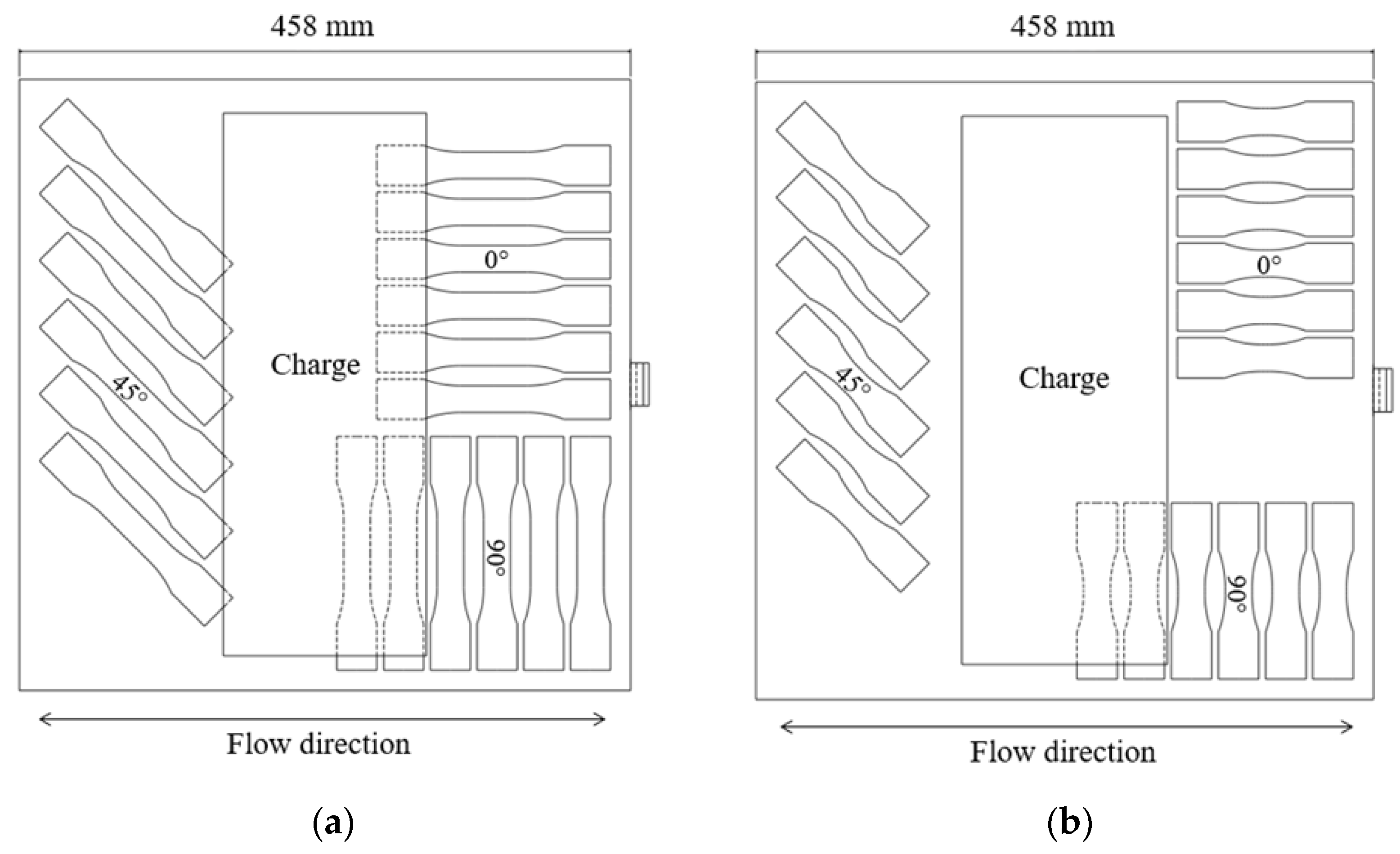



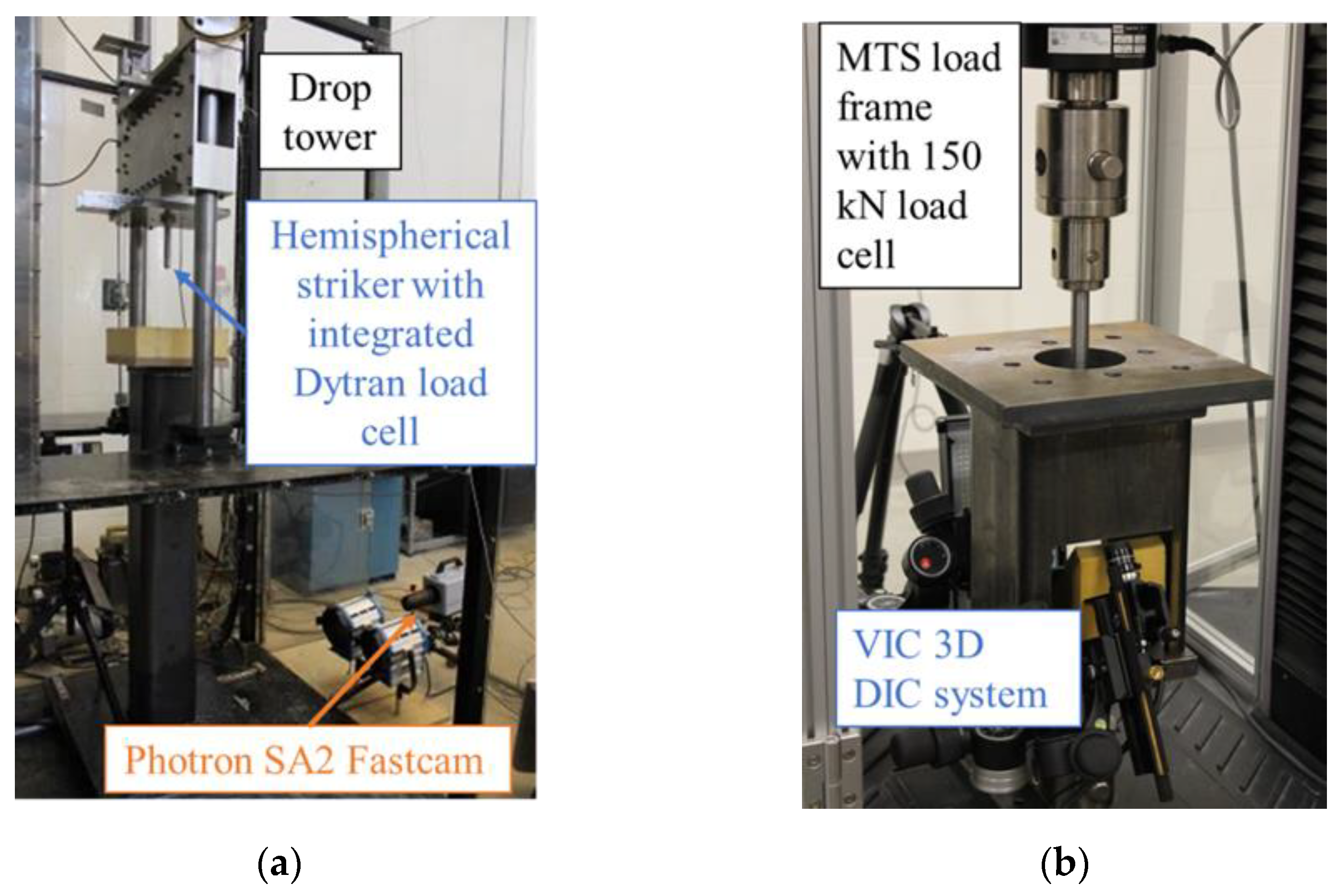
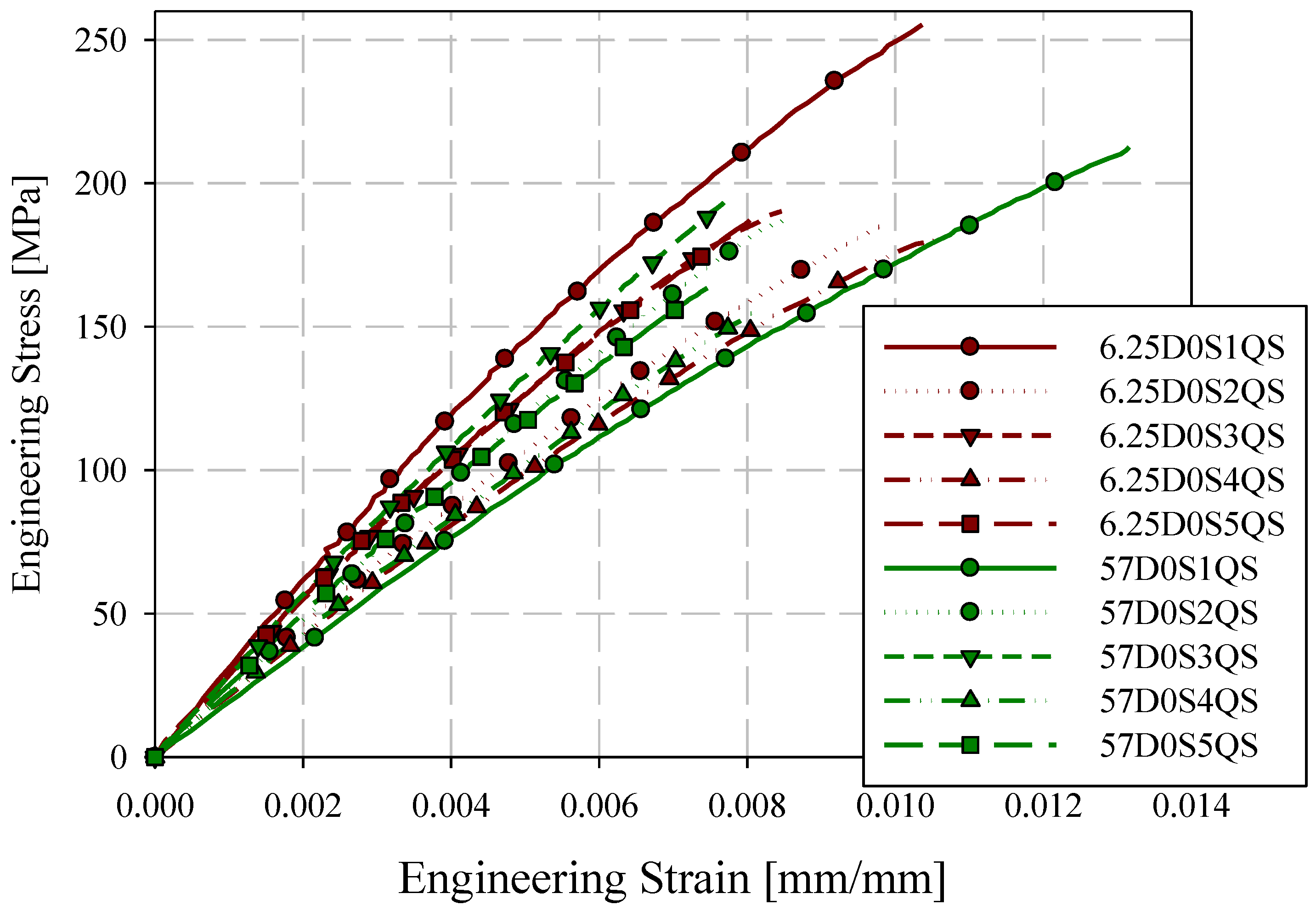





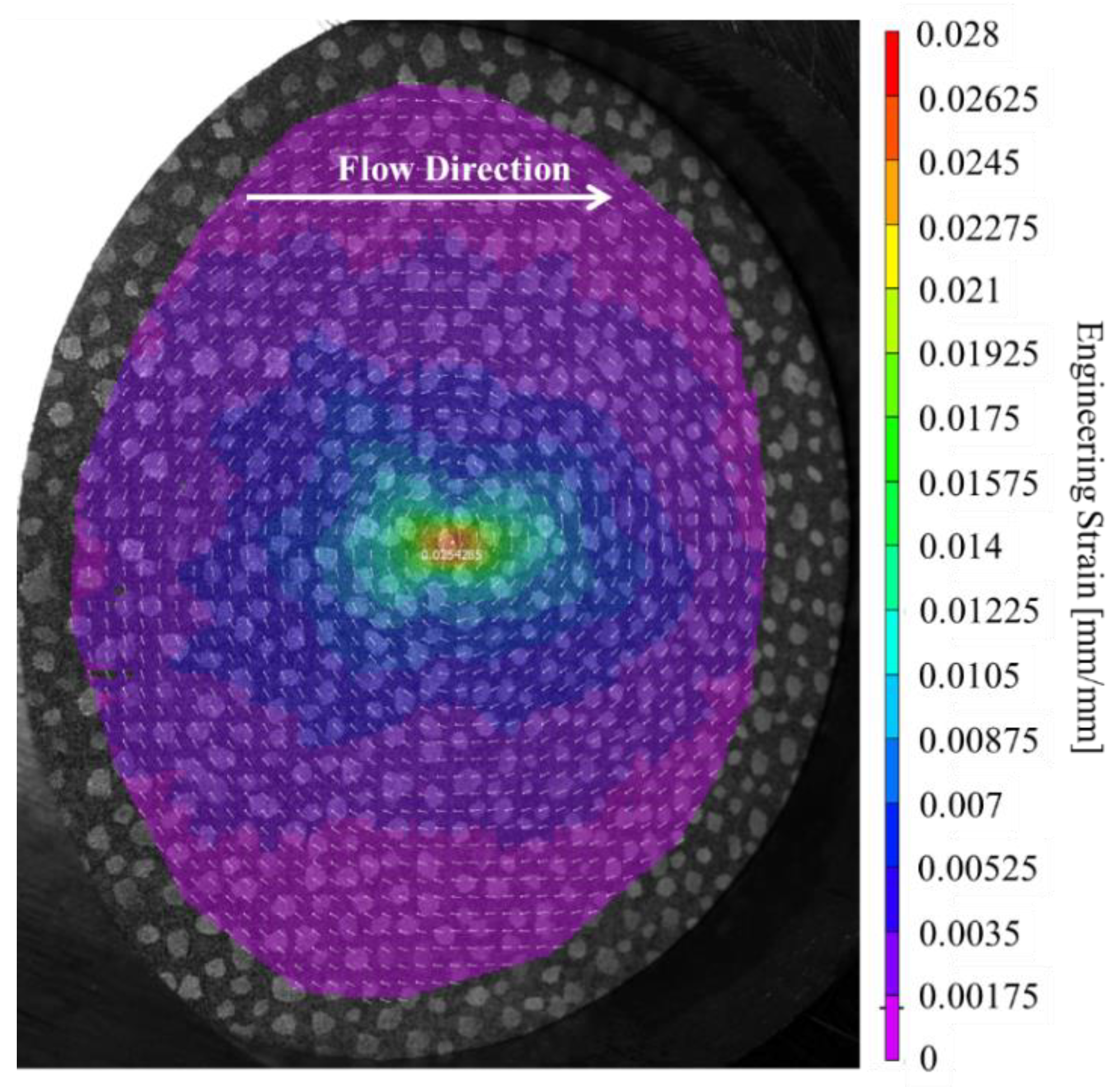



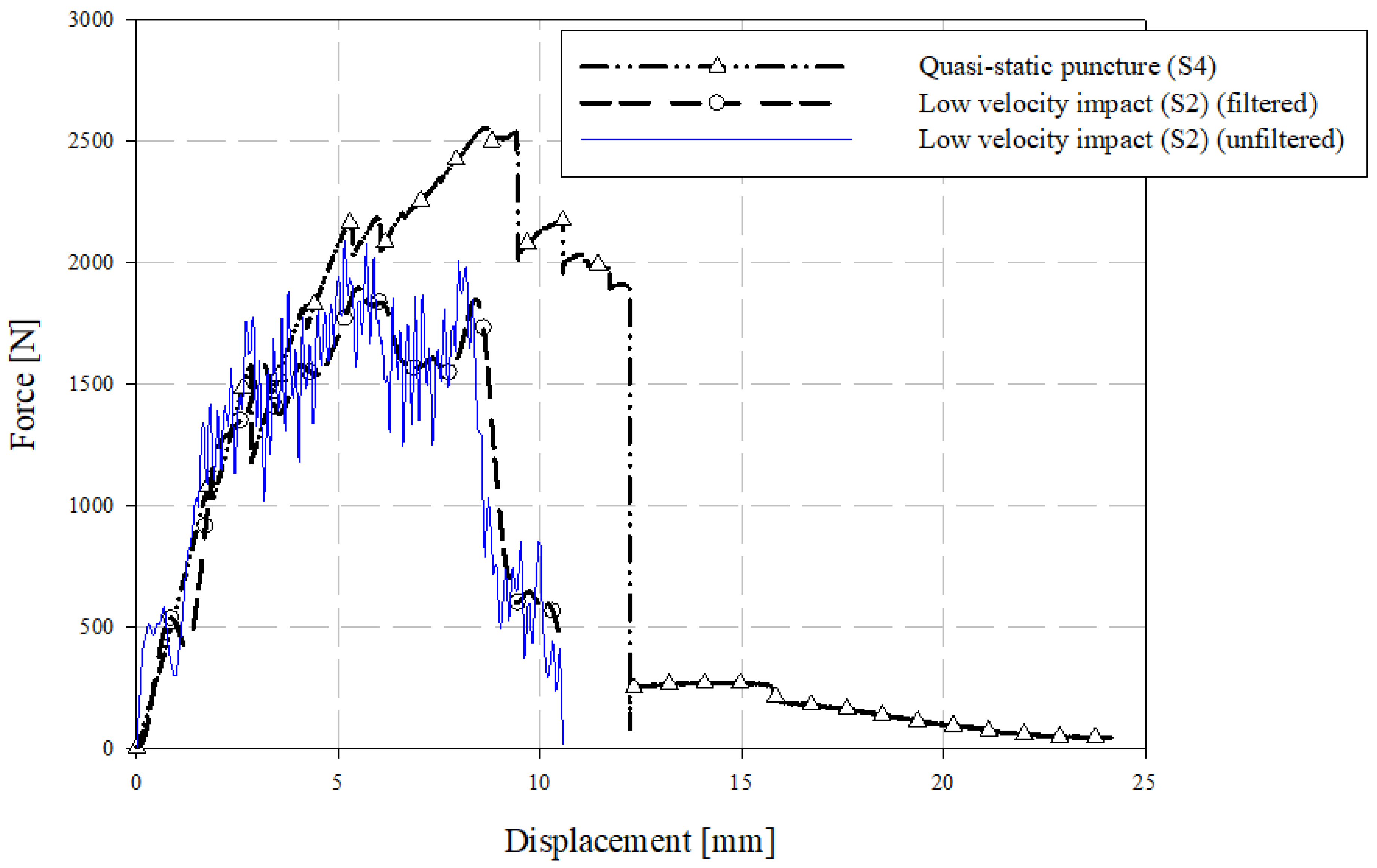
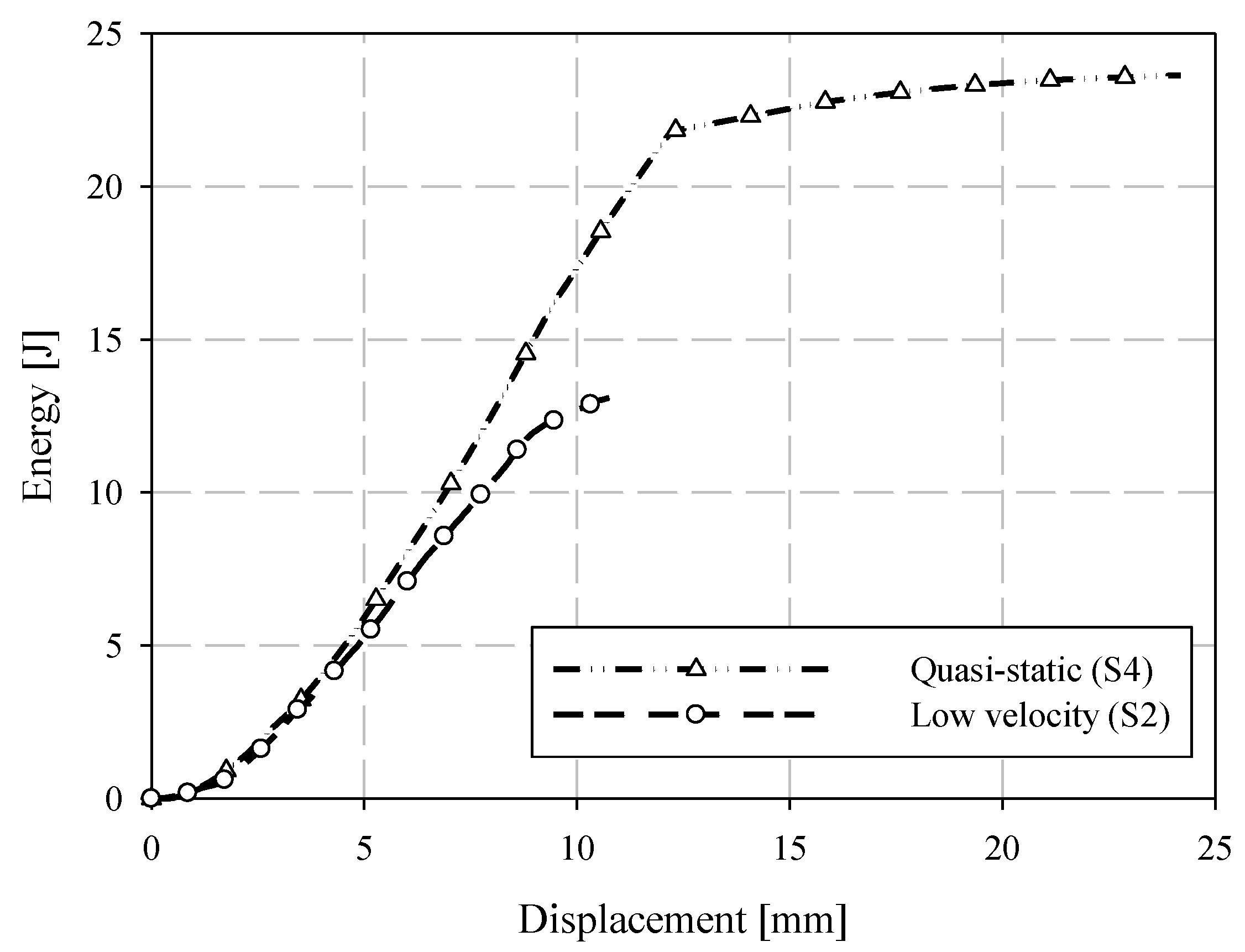
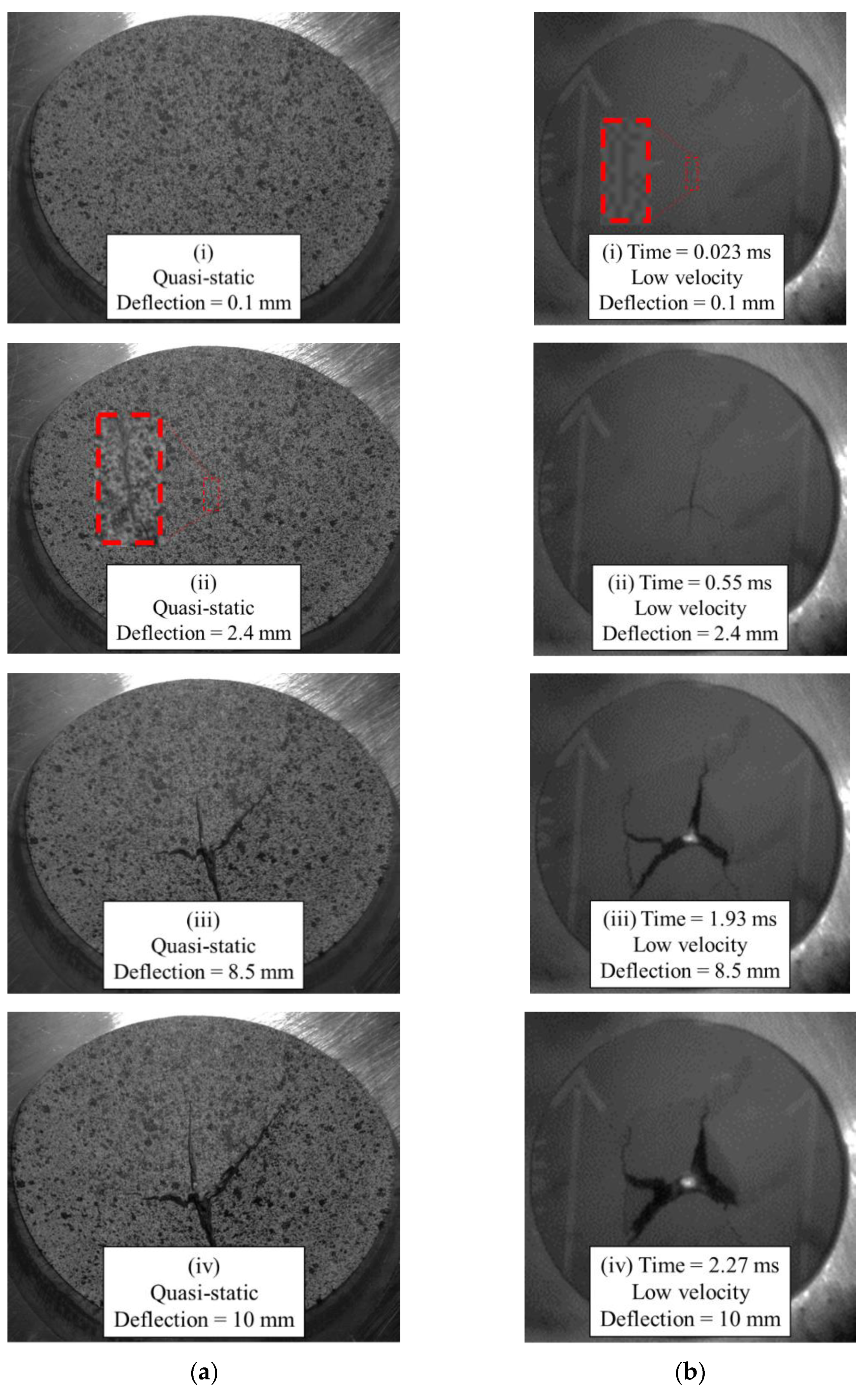
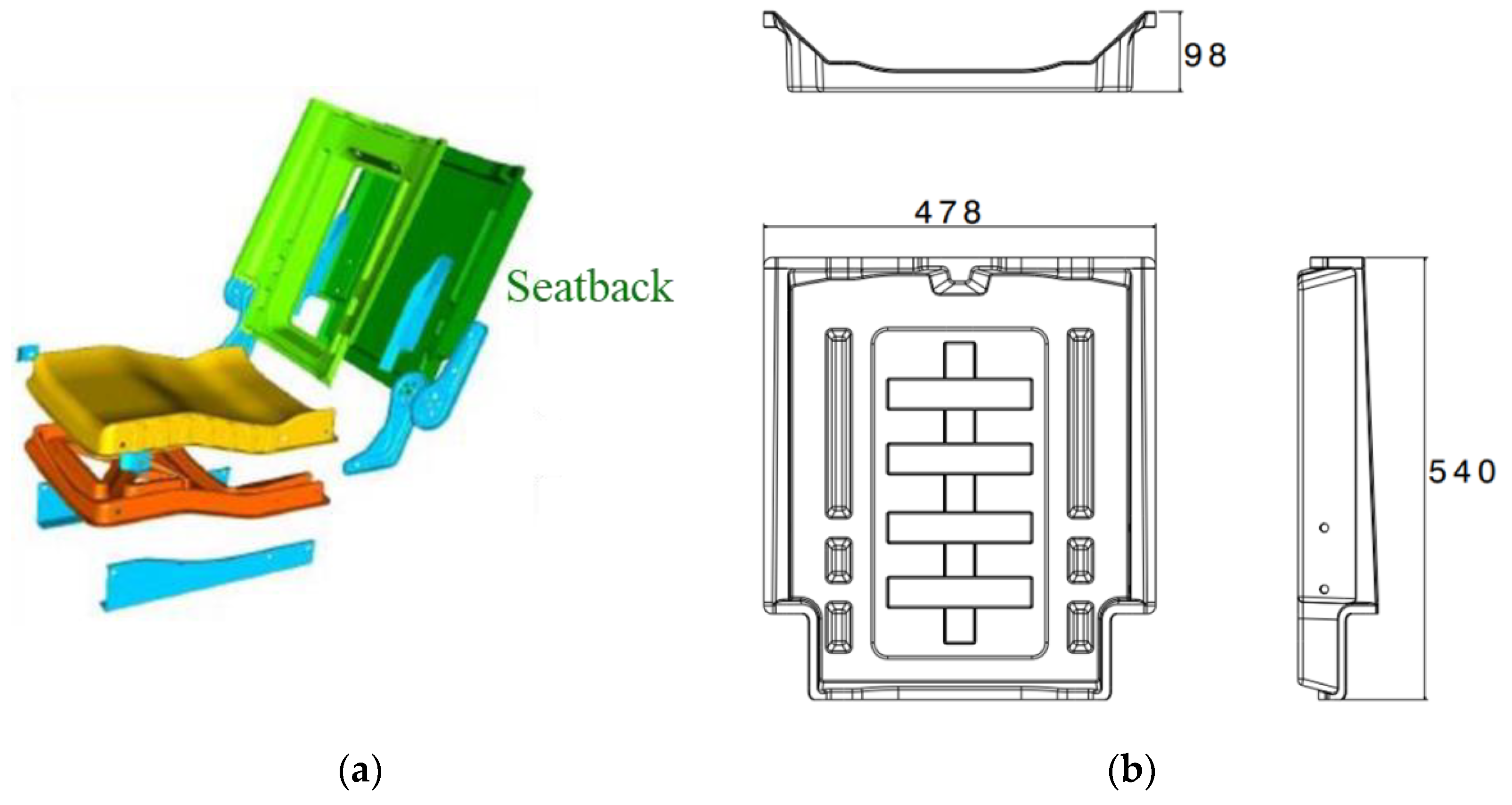


| Material | Summary | Reference |
|---|---|---|
| PA6/CF (2–20%) | Modulus and tensile strength increased with fibre content. Failure strain decreased. Glass transition temperature did not change significantly with fibre content. | [6] |
| PA66/CF (20–30%) | Short fibre and LFT materials compared with improved tensile modulus and strength with increased fibre length. | [7] |
| PA6/clay/CF (10–30%) | Nanoscale clay increased tensile/flexural strength and modulus without reducing impact strength | [8] |
| PA6/PP Blends 20% CF | PA6/PP blend to reduce the sensitivity of PA6 tensile strength and elastic modulus to moisture content. | [9] |
| PP/CF (LFT) | Increasing tensile/flexural and impact strength up to 25% fibre. Hypothesized that at higher fibre contents increasing void content degrades properties. | [10] |
| Various polymers/CF | Review paper on surface modification of carbon fibre for polar thermoplastic matrix materials | [2] |
| Material | Summary | Reference |
|---|---|---|
| PA6/CF (9–25%) | Fundamental mechanical characterization including elastic and flexural moduli, tensile strength, and strain to failure. µCT characterization of fibre orientation. Fibre length characterization. | [11] |
| PA6/CF (9–25%) | ISO 6603-2 instrumented puncture impact testing. | [12] |
| PA66/CF (40%) | Tension-tension (R = 0.1) stress-life fatigue characterization and SEM studies of fracture surfaces. | [13] |
| PA66/GF PA66/CF | TGA, DSC, and GPC characterization. | [14] |
| Notes | Cavity | Core |
|---|---|---|
| Set point at beginning of the trial | 135 °C | 140 °C |
| Initial surface temperature readings | 110 °C | 112 °C |
| Surface temperature after 25 charges | 119 °C | 127 °C |
| Surface temperature after 50 charges | 120 °C | 126 °C |
| Surface temperature after 75 charges | 120 °C | 128 °C |
| Set point after lunch break | 145 °C | 150 °C |
| Initial surface temperature readings | 124 °C | 126 °C |
| Surface temperature after end of trials | 130 °C | 136 °C |
| Specimen Group | Strain Rate [s−1] | Elastic Modulus [GPa] | Tensile Strength [MPa] | Engineering Strain at Failure [%] | Poisson’s Ratio [υ] |
|---|---|---|---|---|---|
| 6.25D0 | 4.9 × 10−5 (15.1%) | 24.6 (15.0%) | 201.2 (15.8%) | 1.34 (21.2%) | 0.358 (10.7%) |
| 12.7D0 | 6.6 × 10−5 (8.5%) | 24.0 (8.5%) | 206.8 (6.5%) | 1.06 (15.3%) | 0.426 (15.4%) |
| 25D0 | 6.2 × 10−5 (20.8%) | 20.6 (5.7%) | 182.9 (9.4%) | 1.01 (14.7%) | 0.506 (17.8%) |
| 57D0 | 5.8 × 10−5 (20.2%) | 23.1 (13.1%) | 186.3 (12.1%) | 0.90 (25.6%) | 0.401 (24.7%) |
| 0° Sensitivity to Gauge Length | 2.3% | −5.8% | −9.6% | −27.5% | 3.5% |
| 6.25D90 | 1.6 × 10−4 (18.5%) | 9.45 (18.4%) | 93.3 (23.4%) | 1.33 (23.4%) | 0.155 (33.9%) |
| 12.7D90 | 1.3 × 10−4 (16.2%) | 9.42 (17.0%) | 96.9 (13.9%) | 1.34 (21.2%) | 0.206 (37.6%) |
| 25D90 | 1.3 × 10−4 (16.6%) | 8.34 (8.3%) | 89.4 (13.8%) | 1.18 (14.7%) | 0.207 (34.8%) |
| 57D90 | 1.0 × 10−4 (11.5%) | 10.3 (18.2%) | 85.1 (25.9%) | 0.99 (31.2%) | 0.190 (30.3%) |
| 90° Sensitivity to Gauge Length | −35.9% | 10% | −11.1% | −29.9% | 8.1% |
| Specimen Identifier | Elastic Stiffness [N/mm] | Maximum Force [N] | Deflection at Maximum Force [mm] | Absorbed Energy [J] | Deflection at Onset of Fracture [mm] | Principal Strain at Onset of Fracture [%] |
|---|---|---|---|---|---|---|
| ISOS1QS | 650 | 2596 | 12.7 | 23.1 | 2.2 | 2.5 |
| ISOS2QS | 609 | 2297 | 7.2 | 16.2 | 2.3 | 2.7 |
| ISOS3QS | 550 | 2250 | 8.9 | 16.7 | 2.1 | 3.3 |
| ISOS4QS | 620 | 2554 | 8.7 | 23.6 | 2.4 | 5.7 |
| ISOS5QS | 618 | 2415 | 9.5 | 22.2 | 2.2 | 3.8 |
| ISOS6QS | 605 | 2444 | 10.0 | 17.7 | 2.4 | 3.4 |
| Average | 609 N/mm | 2426 N | 9.5 mm | 19.9 J | 2.3 mm | 3.6% |
| Coefficient of variation | 5.4% | 5.6% | 19.3% | 17.1% | 5.3% | 32.2% |
| Specimen Identifier | Elastic Stiffness [N/mm] | Maximum Force [N] (Filtered) | Deflection at Maximum Force [mm] | Absorbed Energy [J] | Deflection Fracture Onset [mm] |
|---|---|---|---|---|---|
| ISOS1LV | 983 | 1836 | 7.3 | 10.2 | <0.1 |
| ISOS2LV | 963 | 1895 | 6.0 | 13.2 | <0.1 |
| ISOS3LV | 958 | 2207 | 9.3 | 15.0 | 0.1 |
| ISOS4LV | 967 | 1927 | 7.7 | 12.8 | <0.1 |
| ISOS5LV | 1016 | 1842 | 7.1 | 12.3 | <0.1 |
| ISOS6LV | 989 | 1793 | 8.4 | 11.8 | <0.1 |
| Average | 979 N/mm | 1917 N | 7.6 mm | 12.6 J | <0.1 mm |
| Coefficient of variation | 2.2% | 7.8% | 14.9% | 12.7% | - |
Publisher’s Note: MDPI stays neutral with regard to jurisdictional claims in published maps and institutional affiliations. |
© 2022 by the authors. Licensee MDPI, Basel, Switzerland. This article is an open access article distributed under the terms and conditions of the Creative Commons Attribution (CC BY) license (https://creativecommons.org/licenses/by/4.0/).
Share and Cite
Bondy, M.; Mohammadkhani, P.; Magliaro, J.; Altenhof, W. Elevated Strain Rate Characterization of Compression Molded Direct/In-Line Compounded Carbon Fibre/Polyamide 66 Long Fibre Thermoplastic. Materials 2022, 15, 7667. https://doi.org/10.3390/ma15217667
Bondy M, Mohammadkhani P, Magliaro J, Altenhof W. Elevated Strain Rate Characterization of Compression Molded Direct/In-Line Compounded Carbon Fibre/Polyamide 66 Long Fibre Thermoplastic. Materials. 2022; 15(21):7667. https://doi.org/10.3390/ma15217667
Chicago/Turabian StyleBondy, Matthew, Pouya Mohammadkhani, John Magliaro, and William Altenhof. 2022. "Elevated Strain Rate Characterization of Compression Molded Direct/In-Line Compounded Carbon Fibre/Polyamide 66 Long Fibre Thermoplastic" Materials 15, no. 21: 7667. https://doi.org/10.3390/ma15217667





